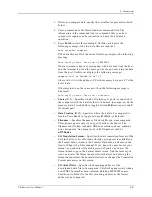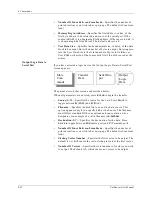
4. Commands
UniSite-xpi User Manual
4-91
•
I/O Translation Format
—Specifies the translation format for the
data. A complete listing of the formats is given in the Translation
Format chapter of this manual.
•
I/O Address Offset
—Enter the desired beginning address of the disk
file. This field appears only if a non-JEDEC format has been selected.
UniSite-xpi adds this value to the address of the data in memory
(relative to the Memory Begin Address of 0) and output the sum as
the I/O address. Entering FFFFFFFF sets the I/O Address Offset to 0.
•
Memory Begin Address
—Specifies the first address, in hex, from
where the first byte of data is retrieved to write to the disk output file.
If the source is RAM, it is a beginning RAM address. If the source is
Disk, it is a beginning disk file address. The default address is 0. This
field appears only if a non-JEDEC format has been selected.
•
User Data Size
—Specifies the hexadecimal size, in bytes, of the data
block to be output, with translation, to the output file from the
source. Enter the number of bytes to output. Entering zero sets User
Data Size to the total number of hex bytes in UniSite-xpi User RAM or
the size of the source disk file if disk is used as source. This field
appears only if a non-JEDEC format has been selected.
Serial Output
Use the Serial Output command to send data from UniSite-xpi to a serial
device, such as a printer.
This command is a useful way to obtain a quick copy of programming or
other device-related data. Serial Output does not do any data translating.
If a logic device is selected, the fuse data is output by fuse number and
the vector data is output by vector number. If a memory device is
selected, the data is output by address in hex format.
Output Memory Data is explained first, followed by Output Logic Data.
Output Memory Data
to Serial Port
When a memory device has been selected, the Serial Output command is
output as a specified memory block to one of UniSite-xpi’s serial ports.
When all parameters described below have been entered, press E
NTER
to
begin the transfer operation.
The parameters for this command are listed below.
•
Source
(R,D)—Specifies the source for the data. Press S
PACE
to
toggle between R (RAM) and D (Disk).
•
Filename
—Specifies the disk file to use as the Source. This option
appears only if you specify disk as the Source. The filename must
follow standard DOS conventions, and can contain a drive
designator. An example of a valid filename is b:27128a.dat.
•
Destination
(R,T)—Specifies the destination for the data. Press
S
PACE
to toggle between R (Remote port) and T (Terminal port).
More
Com-
mands
Serial Out-
put
Output
Memory
Data
Transfer
Data
Summary of Contents for UniSite-xpi
Page 2: ...981 0014 UniSite Programming System User Manual Also Covering Legacy UniSite Programmers ...
Page 72: ...2 Setup and Installation 2 42 UniSite xpi User Manual ...
Page 134: ...3 Getting Started 3 62 UniSite xpi User Manual ...
Page 238: ...5 Computer Remote Control 5 10 UniSite xpi User Manual ...
Page 296: ...6 Translation Formats 6 58 UniSite xpi User Manual ...
Page 402: ...Keep Current Subscription Service 6 Keep Current ...
















































